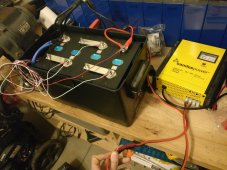Hi everyone,
I'm working through a batch of EVE 280Ah cells from Docan Technology. I built up a 12v pack with 4 of the cells today and connected a 12v OverkillSolar BMS. That went perfect.
I don't have a 12v dedicated lithium battery charger and planned to use my existing Samlex 12v charger that I use for FLA batteries. It's set for 14.4v absorption and 13.5v float, so it should work well enough for charging this pack. Spoiler alert, it's not working like I had hoped.
I have 10 gauge leads coming from the charger terminated with 45 amp Anderson power pole connectors. I have ring connectors bolted to the BMS and battery main positive stud with 10 gauge wire terminated with 45 amp Anderson power pole connectors.
The BMS is seeing 13.4 volts from the charger, confirmed by multimeter. The charger has 3 outputs. The two outputs that I am not using are running at 14.4 volts, confirmed by multimeter. The output I am using is running 14.0 volts, confirmed by multimeter. The charger is getting very warm. I can smell the glue inside of it liquifying again and the heat sink fins are very warm. The bottom of the charger is too hot to handle.
It looks like I'm getting 0.4 volts voltage drop at the charger and another 0.6 volts drop across the Anderson connector. The Anderson connector is also warm to the touch. The wire close to the connector is heating, but close to the battery it is still cool as you would expect. I'm only passing 15 amps, so 10 gauge wire less than 5' total length should not be heating like this. The BMS says that the cells are charging and my multimeter shows the polarity is ok, so I don't think have something reversed and am back feeding the charger.
I have used this charger extensively to charge FLA batteries and have never had anything like this happen. Does anyone have any idea of what could be going wrong here? I can remove the Anderson connector, but I was just charging an FLA yesterday with the same exact cable and there was no problem same as every other time in the last 6 years.
Here's a picture of what I'm working with.

I'm working through a batch of EVE 280Ah cells from Docan Technology. I built up a 12v pack with 4 of the cells today and connected a 12v OverkillSolar BMS. That went perfect.
I don't have a 12v dedicated lithium battery charger and planned to use my existing Samlex 12v charger that I use for FLA batteries. It's set for 14.4v absorption and 13.5v float, so it should work well enough for charging this pack. Spoiler alert, it's not working like I had hoped.
I have 10 gauge leads coming from the charger terminated with 45 amp Anderson power pole connectors. I have ring connectors bolted to the BMS and battery main positive stud with 10 gauge wire terminated with 45 amp Anderson power pole connectors.
The BMS is seeing 13.4 volts from the charger, confirmed by multimeter. The charger has 3 outputs. The two outputs that I am not using are running at 14.4 volts, confirmed by multimeter. The output I am using is running 14.0 volts, confirmed by multimeter. The charger is getting very warm. I can smell the glue inside of it liquifying again and the heat sink fins are very warm. The bottom of the charger is too hot to handle.
It looks like I'm getting 0.4 volts voltage drop at the charger and another 0.6 volts drop across the Anderson connector. The Anderson connector is also warm to the touch. The wire close to the connector is heating, but close to the battery it is still cool as you would expect. I'm only passing 15 amps, so 10 gauge wire less than 5' total length should not be heating like this. The BMS says that the cells are charging and my multimeter shows the polarity is ok, so I don't think have something reversed and am back feeding the charger.
I have used this charger extensively to charge FLA batteries and have never had anything like this happen. Does anyone have any idea of what could be going wrong here? I can remove the Anderson connector, but I was just charging an FLA yesterday with the same exact cable and there was no problem same as every other time in the last 6 years.
Here's a picture of what I'm working with.



